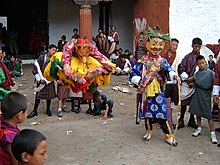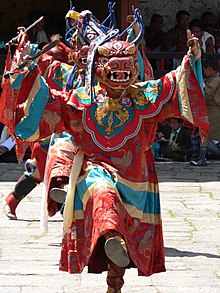
Back Ачэ Лхама Byelorussian ལྷ་མོ་ཟློས་གར་གྱི་རིགས་ཞིག Tibetan Òpera tibetana Catalan Lhamo DAG Lhamo DGA Lhamo FAT Ache Lhamo French Lhamo GUR Lhamo Dutch Acze Lhamo Polish
This article needs additional citations for verification. (April 2021) |




Lhamo (Standard Tibetan: ལྷ་མོ, romanized: Lha mo), or Ache Lhamo, is a classical secular theatre of Tibet with music and dance that has been performed for centuries, whose nearest western equivalent is opera. Performances have a narrative and simple dialogue interspersed with comedy and satire; characters wear colorful masks. The core stories of these theatrical plays are drawn mostly from ancient Indian Buddhist folk tales, lives of important people and historical events from Tibetan civilization. However the ceremonial, dance and ritual spectacles strongly reflects the Tibetan Royal Dynastic period.
Very similar traditions are found in Bhutan and other regions influenced by Tibetan Buddhism and Tibetan culture. There are at least three unique schools of Lhamo: Kyimulunga, Gyangara, and Chungba.[1]
- ^ Ahmed, Syed Jamil (Spring 2006). "Tibetan Folk Opera: "Lhamo" in Contemporary Cultural Politics". Asian Theatre Journal. 23 (1): 149–178. doi:10.1353/atj.2006.0001. JSTOR 4137092. S2CID 49340054. Retrieved 7 April 2021.